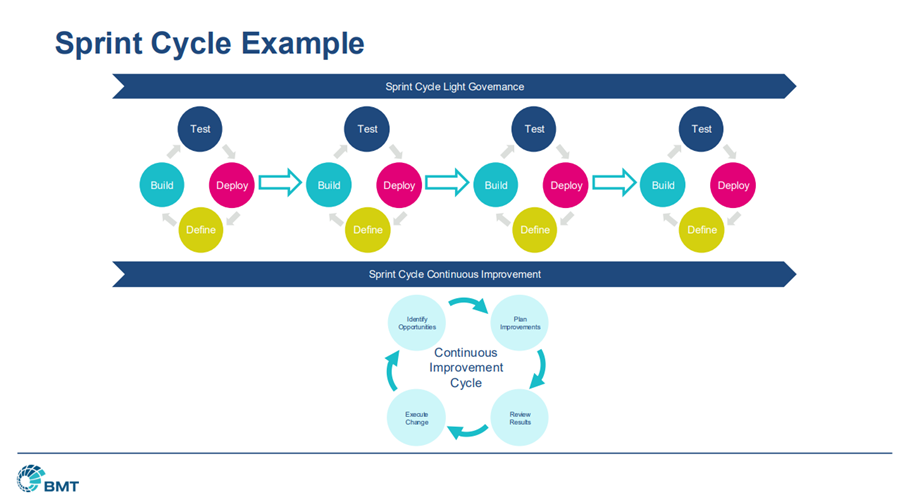
17 November 2025
Imagine trying to chart a course through a landscape that’s still forming. The destination is clear, but the terrain shifts as you move forward. That’s what defining a programme often feels like; especially in complex, fast-evolving environments.
In these situations, a rigid, one-shot approach to programme definition can become a liability. It assumes certainty where there is none. It locks in decisions before the full picture is known. And it risks building a structure that’s elegant on paper but brittle in practice.
We’ve found that a more adaptive approach works best; one that embraces iteration, feedback, and flexibility, leads to stronger outcomes, better engagement, and more resilient delivery. It’s not about being vague or unstructured. It’s about being responsive, deliberate, and open to learning as you go.
Defining a programme is often treated like writing a manual: gather the requirements, write the document, get sign-off, and move on. In reality, it’s more like designing a living system. It needs to breathe, evolve, and respond to its environment.
In our client work, we’ve seen three principles consistently underpin successful adaptive programme definition:
At the outset of a programme, you may have a vision or a target operating model, but not a detailed map. That’s okay. The goal is to define enough to move forward, while leaving space to refine as you learn more. Think of it like sketching the scaffolding before the building takes shape.
Rather than trying to write the perfect Programme Definition Document (PDD) in one go, break it into features or components. Develop each one through short cycles: draft, review, refine. This allows for early feedback, better alignment, and higher quality. It also creates momentum and a sense of shared ownership. Figure 1, shows an example of an iterative approach, which balances the sprint cycle with light governance and continuous improvement.

Figure 1: Example of a Sprint Cycle
Adaptive doesn’t mean chaotic. It means having a governance framework that’s rigorous but light. A framework that enables decision-making, manages risk, and supports change without becoming a bottleneck. It’s the difference between a scaffolding that supports growth and a cage that restricts it.
This approach is especially valuable when the programme is exploratory in nature, when you’re testing new ideas, engaging with a wide range of stakeholders, or working in a space where the technology or policy landscape is still shifting.
It also helps when you’re working with multiple delivery partners or suppliers. An adaptive approach allows you to bring them in at the right time, with the right level of definition, and co-create the path forward.
We recently supported a client in defining a complex, multi-phase programme aimed at developing early-stage technologies. The programme was ambitious, cross-cutting, and operating in a space where the “what” was clear, but the “how” was still emerging.
Rather than trying to lock everything down upfront, we took an adaptive approach to programme definition. Here’s how it worked in practice:
We structured the definition phase into five sprint cycles. Each sprint had a clear focus team mobilisation, initial research, stakeholder engagement, feature development, and compilation. This gave us a rhythm and a sense of progress, while allowing us to respond to new information as it emerged.
We developed the Programme Definition Document feature by feature. Each feature (such as governance, stakeholder engagement, risk management, or delivery planning) was treated as a mini-project. It was drafted, reviewed, and refined through collaboration with the client and the wider team.
This approach had several benefits:
We also ran a series of workshops to support the definition process. A vision and risk workshop helped align stakeholders around the programme’s goals and surface key risks. A stakeholder mapping session helped prioritise engagement. And an industry day brought external partners into the conversation, setting the tone for future collaboration.
With the definition in place, we moved into resource mobilisation. This involved securing funding, setting up commercial agreements, and preparing for the first tranche of delivery. Again, the definition continued to evolve, refined through feedback, shaped by emerging requirements, and informed by ongoing engagement.
The delivery phase was designed to be tranche-based and flexible. Projects could be commissioned, paused, or pivoted based on progress and learning. This allowed the programme to pursue promising ideas, drop dead ends, and adapt to changing circumstances.
Figure 2, shows a visual representation of how defining a complex, multi-phased programme aimed at developing early-stage technologies looked in principle.

Figure 2: Example of an Adaptive Approach to Programme Management
Taking an adaptive approach wasn’t always easy. It required discipline, transparency, and a willingness to let go of the illusion of control. But it paid off.
Here are some of the key lessons we took away:
Defining a programme isn’t about writing a perfect document. It’s about creating a shared understanding of what you’re trying to achieve, how you’ll get there, and how you’ll adapt along the way.
An adaptive approach helps you do that. It allows you to start with intent, build clarity through iteration, and stay responsive to change. It creates space for collaboration, learning, and continuous improvement. And it leads to programmes that are not only well-defined, but well-positioned to succeed.
In a world where complexity is the norm and certainty is rare, adaptability isn’t a luxury, it’s a necessity. And when we combine it with empathy, structure, and a commitment to quality, we create programmes that deliver real, lasting value.

Louis Ohomele is a senior management consultant with deep experience leading complex transformation programmes for government and infrastructure clients. With expertise in Agile delivery, portfolio governance, and operating model design. He helps organisations achieve measurable outcome through adaptive, value driven approaches to programme management. He is recognised for applying adaptive delivery methods, strong governance, and collaborative leadership to achieve sustainable, high value change.

N/A
In a world where complexity is the norm and certainty is rare, adaptability isn’t a luxury, it’s a necessity. And when we combine it with empathy, structure, and a commitment to quality, we create programmes that deliver real, lasting value.

Tim Curtis
Most transformation programmes fail—not because of poor execution, but because they never truly understood the race they were competing in. The BMT Strategy Canvas changes that.

Kathryn Walker
Coaching is a proven tool to support change leaders and their teams. The greatest impact and success has been achieved in transformation programmes, where structural and programmatic approaches are supported by attention to the cultural and behavioural aspects of change.

Will Roberts
At BMT, we believe simulation is a critical enabler in overcoming these hurdles—de-risking development, accelerating innovation, and building confidence across the entire lifecycle of autonomous systems.